*NURSING > EXAM > AGNP BOARD EXAM QUESTIONS Assessment of Gastroenterology (84 Questions) 100% verified with detailed (All)
AGNP BOARD EXAM QUESTIONS Assessment of Gastroenterology (84 Questions) 100% verified with detailed and explained solutions
Document Content and Description Below
AGNP BOARD EXAM QUESTIONS Prescription Gastroenterology (85 Questions) Question: A 45-year-old woman has been taking oral omeprazole (Prilosec) 40 mg twice daily for the treatment of gastroesoph... ageal reflux. To discontinue the medication the nurse practitioner would: advise the patient to stop the medication. reduce the dose by 50% every other day. reduce the dose by 50% weekly. Correct reduce dose by 50% every month. Explanation: For patients on a moderate to high dose of a PPI (e.g., omeprazole (Prilosec) 40 mg daily or twice daily), reduce the dose by 50% every week until the patient is on the lowest dose of the medication. For patients on twice daily dosing, the initial reduction can be accomplished by decreasing the dosing to once in the morning before breakfast. Once the patient has completed a week at the lowest dose, the medication can be discontinued. Question: Patients receiving long-term proton pump inhibitors (PPIs) are at increased risk for fractures and: lower extremity edema. extraesophageal symptoms. myocardial infarction. Correct muscle spasms. Explanation: Analysis of patients taking PPIs for long periods of time showed an increased risk of myocardial infarctions. This is thought to be related to reduced nitric oxide in the blood vessel walls. The FDA suggests that providers consider periodically obtaining magnesium levels in patients while they are on a PPI. Increased risk of myocardial infarction has not been associated with histamine receptor blockers. Question: Ondansetron (Zofran) dosage should be adjusted in patients: with renal insufficiency. who are pregnant. who are > 65 years old. with hepatic impairment. Correct Explanation: Ondansetron (Zofran) is a 5-HT3 receptor antagonist used for the treatment of nausea and vomiting. Dose limitations are recommended for patients with severe hepatic impairment (Child- Pugh class C); use with caution in mild-moderate hepatic impairment; clearance is decreased and half-life increased in hepatic impairment. No dosage adjustment is recommended with renal insufficiency, pregnancy or in advanced age. Question: The antiemetic that does NOT have potential to cause QT prolongation is: promethazine (Phenergan). Correct chlorpromazine (Thorazine). ondansetron (Zofran). prochlorperazine (Compazine). Explanation: Antihistamines such as promethazine and diphenhydramine do not cause QT prolongation. Dopamine and serotonin antagonists are both associated with QT prolongation. Chlorpromazine (Thorazine) and prochlorperazine (Compazine) are dopamine antagonists. Ondansetron (Zofran) is a serotonin antagonist. If a patient has suspected QT interval prolongation or is taking other medications with which the QT interval prolongation could be additive, a 12-lead EKG is recommended before treatment is initiated. Question: Promethazine (Phenergan), a 1st generation antihistamine, is contraindicated in the presence of: motion sickness. sedation. asthma. Correct seasonal allergic rhinitis. Explanation: Promethazine (Phenergan) is contraindicated in patients with hypersensitivity reaction to promethazine, other phenothiazines, or any component of the formulation; coma; lower respiratory tract symptoms, including asthma; children younger than 2 years of age; intra-arterial or subcutaneous administration. Question: Oral metoclopramide is contraindicated in the patient diagnosed with: migraines. epilepsy. Correct diabetes. renal impairment. Explanation: Metoclopramide (Reglan) is contraindicated in situations when gastrointestinal (GI) motility may be dangerous, including mechanical GI obstruction, perforation, or hemorrhage; pheochromocytoma; history of seizure disorder (e.g., epilepsy); and concomitant use with other agents likely to increase extrapyramidal reactions. Caution is advised in patients with renal impairment; dosage adjustment may be needed. Question: Hyperosmotic agents and saline laxatives should be avoided or used with caution in patients who have: chronic constipation. liver disease. heart failure. Correct hypothyroidism. Explanation: Hyperosmotic agents and saline laxatives may seriously alter fluid and electrolyte balance. This increases the risk for dehydration and electrolyte disturbances, especially hypokalemia. Therefore, the risks versus the benefits should be considered prior to use in patients with heart failure. Question: Corticosteroids, used in the treatment of ulcerative colitis, usually do NOT: increase the rate of infection. reduce the effectiveness of vaccines. increase the effectiveness of antibiotics. Correct increase the risk of developing osteoporosis. Explanation: Corticosteroids usually do NOT increase the effectiveness of antibiotics; they reduce their effectiveness. Because they suppress the immune system, they increase the rate of infection, reduce the effectiveness of vaccines and increase the risk of osteoporosis and fractures due to loss of calcium with corticosteroids. Question: The plasma elimination half-life of esomeprazole (Nexium) is: 1-1.5 hours. Correct 2-3 hours. 3.5-5 hours. 6-8 hours. Explanation: The plasma elimination half-life of esomeprazole (Nexium) is approximately 1 to 1.5 hours. Less than 1% of the parent drug is excreted in the urine. Approximately 80% of an oral dose of esomeprazole is excreted as inactive metabolites in the urine, and the remainder is found as inactive metabolites in the feces. Question: Proton pump inhibitors (PPIs), such as pantoprazole (Protonix), block gastrointestinal acid secretion by: converting cations to anions and pumping from parietal cell to the secretory canaliculus. prohibiting the pumping of hydrogen ions into the parietal cell. inhibiting the hydrogen-potassium ATPase transport enzyme. Correct inhibiting the sodium-potassium ATPase transport enzyme. Explanation: The recognition that H-K-ATPase was the final step of acid secretion culminated in the development of a class of drugs, the proton pump inhibitors (PPIs), which are targeted at inhibiting this enzyme. They are most effective when the parietal cell is stimulated to secrete acid postprandially, a relationship that has important clinical implications for timing of administration. Because the amount of H-K-ATPase present in the parietal cell is greatest after a prolonged fast, PPIs should be administered before the first meal of the day. Question: A 7-10 day regimen of ciprofloxacin (Cipro) plus metronidazole (Flagyl) is indicated for the outpatient treatment of: bacterial vaginosis. uncomplicated diverticulitis. Correct Clostridium difficile. gastroenteritis. Explanation: A 7-10 day course of oral ciprofloxacin (Cipro) plus metronidazole (Flagyl) is appropriate for the outpatient management of uncomplicated diverticulitis. This regimen provides adequate coverage of common gastrointestinal flora of gram-negative rods and anaerobes. Question: Ranitidine (Zantac), a histamine receptor antagonist, is contraindicated in: children. pancreatitis. phenylketonuria (PKU). Correct Zollinger-Ellison disease. Explanation: Some H2-blockers contain aspartame. Aspartame is converted to phenylalanine and must be used with caution in patients with PKU. The Pepcid AC brand of famotidine chewable tablets contains 1.4 mg of phenylalanine per 10-mg dose. The Pepcid RPD brand of famotidine oral dispersible tablets contains 1.05 mg of phenylalanine per 20-mg dose. The Zantac brand of ranitidine EFFERdose tablets contains 2.81 mg of phenylalanine per 25-mg dose and 16.84 mg of phenylalanine per 150-mg dose. Question: A patient who has been taking a proton pump inhibitor for the last 6 months reports persistent diarrhea for the past 3 weeks. The nurse practitioner should consider: colitis. gastroparesis. bacterial gastroenteritis. Clostridium difficile. Correct Explanation: The US Food and Drug Administration (FDA) has issued a safety alert encouraging providers to consider a diagnosis of Clostridium difficile-associated disease in PPI users with persistent diarrhea. Given the potential risk of Clostridium difficile infection, the FDA has also recommended that providers prescribe the lowest dose and shortest duration of PPI therapy appropriate to the condition being treated. Question: Histamine receptor antagonists (H2RA), such as famotidine (Pepcid), inhibit acid secretions by: blocking the parietal cells (acid-producers) from responding to histamine. Correct blocking transport of histamine across the ATPase Pump. antagonizing the release of histamine from the enterochromaffin-like cells (ECL cells). antagonizing hydrogen ions from responding to histamine. Explanation: H2 blockers inhibit the parietal cells in the stomach lining from responding to histamine. This reduces the amount of acid produced by the stomach. H2RA blockers include: famotidine (Pepcid); ranitidine (Zantac), and nizatidine (Axid). Question: The length of treatment for oral metoclopramide should NOT exceed: 4 weeks. 8 weeks. 10 weeks. 12 weeks. Correct Explanation: Avoid treatment with metoclopramide for longer than 12 weeks in all but rare cases in which therapeutic benefit is thought to outweigh the risk of developing tardive dyskinesia. Oral metoclopramide is indicated for adults only. Question: A 42-year-old patient is being treated with 40 mg of famotidine (Pepcid) daily for the treatment of duodenal ulcers. The best time for the patient to take this medication is: on an empty stomach, 1 hour prior to breakfast. with breakfast. prior to the largest meal of the day. at bedtime. Correct Explanation: Oral dosage forms of famotidine (suspension, tablets, chewable tablets, and oral disintegrating tablets) used to treat duodenal ulcers are typically administered once a day at bedtime. BID dosing is also accepted. Question: Topical steroid cream, used in the treatment of hemorrhoids, should be applied twice daily for no more than: 3 days. 5 days. 7 days. Correct 10 days. Explanation: Topical steroid cream may be used to relieve pruritus and reduce the size of hemorrhoids. It should be applied to the site twice daily for no more than 7 days to avoid potential thinning of perianal and anal mucosa and reduce the risk of injury. Question: The drug of choice for the prevention of postoperative nausea and vomiting (PONV) is: droperidol (Inapsine). chlorpromazine (Thorazine). ondansetron (Zofran). Correct promethazine (Phenergan). Explanation: Ondansetron (Zofran) has a limited side effect profile and doesn’t adversely affect the postoperative course. The manufacturer recommends administering preoperatively for the prevention of postoperative nausea and vomiting. Although droperidol (Inapsine), chlorpromazine (Thorazine) and promethazine (Phenergan) are indicated for the treatment of nausea and vomiting, they are not indicated for the prevention of post operative nausea and vomiting. Promethazine has a more extensive side effect profile than Zofran. Question: Long-term use of histamine receptor antagonists (H2RA), such as ranitidine (Zantac), has been associated with: hypermagnesemia. vitamin B12 deficiency. Correct iron deficiency. hypocalcemia. Explanation: Long-term H2RA use, for the treatment of gastroesophageal reflux, is associated with B12 deficiency. Proton pump inhibitors are associated with hypomagnesemia, calcium malabsorption, vitamin B12 and iron deficiency. H2RA blockers include: famotidine (Pepcid); ranitidine (Zantac), and nizatidine (Axid). Question: Due to potential for extrapyramidal symptoms, oral metoclopramide (Reglan) should NOT be administered concomitantly with: sertraline (Zoloft). Correct hydralazine (Apresoline). hydromorphone (Dilaudid). lamotrigine (Lamictal). Explanation: Concomitant use of drugs that can cause extrapyramidal symptoms should be avoided unless absolutely necessary. These drugs include some antipsychotics (Abilify), selective serotonin reuptake inhibitors (i.e. Zoloft), selective norepinephrine reuptake inhibitors (Cymbalta), and norepinephrine-dopamine reuptake inhibitors (Wellbutrin). Hydralazine (Apresoline) is a vasodilator/nitrate; hydromorphone (Dilaudid) is an opioid; lamotrigine (Lamictal) is an antiepileptic. Question: Prior to the initiation of long-term treatment with a proton pump inhibitor (PPI) and periodically during therapy, the nurse practitioner should monitor serum: potassium. sodium. magnesium. Correct calcium. Explanation: Hypomagnesemia due to reduced intestinal absorption has been described with PPI use. It is recommended that serum magnesium levels be obtained prior to starting a PPI when patients are expected to be on the medication for long periods of time, or in patients who take PPIs in conjunction with other medications associated with hypomagnesemia (e.g., digoxin or diuretics). Question: Drug classes used as antiemetics do NOT include: benzodiazepines. glucocorticoids. antidepressants. Correct cannabinoids. Explanation: As single agents, the benzodiazepines are relatively weak antiemetic agents. Glucocorticoids are effective and well-tolerated antiemetics for chemotherapy-induced emesis. The modest antiemetic activity of this class of agents, combined with their relatively unfavorable side effect profile (vertigo, xerostomia, hypotension, dysphoria), especially in older patients, has limited their clinical utility. Antidepressants are not utilized as antiemetics. Question: Patients who take corticosteroids for Crohn's disease should be instructed to notify the nurse practitioner if pain develops in the: wrist. elbow. hip. Correct lower back. Explanation: The long term use of corticosteroids may lead to avascular necrosis of the hip joints that may require surgery. Hip or knee pain in people taking corticosteroids requires prompt medical attention. Question: Corticosteroids, used in the treatment of ulcerative colitis, are produced by the: pituitary gland. hypothalamus. adrenal glands. Correct pancreas. Explanation: Corticosteroids are produced by the adrenal glands in the cortex. Oral and parenteral corticosteroids are used to manage more severe exacerbations. These are ineffective as maintenance therapy to keep ulcerative colitis in remission. Question: Metoclopramide, for the treatment of gastroesophageal reflux, should be administered orally: 30 minutes after meals and at bedtime. 30 minutes prior to meals and at bedtime. Correct with meals. with a full glass of water before bed. Explanation: Metoclopramide (Reglan), an antiemetic for the treatment of gastroesophageal reflux and other nausea/vomiting producing diseases, should be administered 30 minutes prior to meals and at bedtime when administered orally in tablet, elixir or orally disintegrating tablets. Question: The brand name of omeprazole is: Prevacid. Prilosec. Correct Protonix. Probenecid. Explanation: The brand name for omeprazole is Prilosec. The generic name for Prevacid is lansoprazole. The generic name for Protonix is pantoprazole. Probenecid is used to treat gout. Question: Which medication may be used in infants for the treatment of functional constipation? Senna (Senokot) Mineral oil Bisacodyl (Dulcolax) Polyethylene glycol 3350 (MiraLax) Correct Explanation: Polyethylene glycol 3350 (MiraLax) is an osmotic laxative and is considered safe for use in infants. Mineral oil is contraindicated in infants due to an increased risk for aspiration. Senna (Senokot) and bisacodyl (Dulcolax) are stimulant laxatives and not recommended in this age group for the treatment of functional constipation. Question: Patients should be advised to remove the scopolamine patch if an adverse reaction occurs, such as: constipation. confusion. Correct drowsiness. mydriasis. Explanation: Confusion may indicate the beginnings of toxic psychosis caused by scopolamine and the drug should be stopped if confusion occurs. Constipation, drowsiness and mydriasis are all side effects of scopolamine. However, they are not considered an adverse reaction. Constipation can be alleviated with increased fluids. Drowsiness and mydriasis usually resolve within a few days. Question: For patients who didn’t respond to an initial course of triple therapy for Helicobacter pylori, an alternate regimen should be prescribed. It would include a proton pump inhibitor (PPI) and: amoxicillin and clarithromycin. amoxicillin and cephalexin. metronidazole and clarithromycin. metronidazole and tetracycline. Correct Explanation: For patients who didn’t respond to an initial course of triple therapy for Helicobacter pylori, tetracycline may be more effective than metronidazole. The recommended regimen contains amoxicillin, omeprazole, and bismuth salts plus either metronidazole or tetracycline. Clarithromycin should not be used unless resistance testing confirms the H. pylori strain is susceptible to the drug. Antibiotics previously taken for prior treatment should generally be avoided. Question: In the patient with an allergy to penicillin, treatment of Helicobacter pylori would include a proton pump inhibitor plus: amoxicillin and clarithromycin. amoxicillin/clavulanate and tetracycline. metronidazole and clarithromycin. Correct amoxicillin and cephalexin. Explanation: The regimen most commonly recommended for first-line treatment of Helicobacter pylori is triple therapy with a proton pump inhibitor (PPI), amoxicillin (1 g twice daily), and clarithromycin (500 mg twice daily) for 7 to 14 days. In patients with a known allergy to amoxicillin, metronidazole should be prescribed. Question: The brand name of pantoprazole is: Prevacid. Prilosec. Protonix. Correct Probenecid. Explanation: The brand name of pantoprazole is Protonix. It is classified as a proton pump inhibitor. The brand name of omeprazole is Prilosec. The generic of Prevacid is lansoprazole. Probenecid is used to treat gout. Question: In patients with severe renal failure, the dosage of histamine receptor antagonists (H2RA) should be reduced by: 25%. 30%. 50%. Correct 75%. Explanation: The dose of all the H2RAs is generally reduced by 50% in patients with severe renal failure. The plasma half-life is prolonged and total clearance is reduced in the elderly population due to a decrease in renal function. The elimination half-life is 3.1 hours. H2RA blockers include: famotidine (Pepcid); ranitidine (Zantac), and nizatidine (Axid). Question: The bioavailability and time to peak of oral ondansetron (Zofran) in the treatment of noncancerous nausea and vomiting are: 30% and 2 hours. 50% and 1 hour. 60% and 2 hours. Correct 80% and 1 hour. Explanation: Bioavailability of oral ondansetron (Zofran) is 50% to 70% due to some first-pass metabolism. In cancer patients (adults), it demonstrates 85% to 87% bioavailability possibly related to changes in metabolism. The time to peak is about 2 hours. Question: The generic name for Dramamine is: doxylamine. diphenhydramine. brompheniramine. dimenhydrinate. Correct Explanation: The generic name of Dramamine is dimenhydrinate. Dramamine is classified as an antihistamine. It may be used to treat allergies or dizziness. The brand name for doxylamine is Unisom; diphenhydramine is Benadryl; brompheniramine is Bromax. Question: Which of the following agents is NOT typically used to treat symptoms of pain and bloating associated with diarrhea-predominant irritable bowel syndrome (IBS)? Dicyclomine (Bentyl) Peppermint oil Linaclotide (Linzess) Correct Hyoscyamine (Levsin) Explanation: Antispasmodics and peppermint oil may be prescribed as needed and/or prophylactically in the event of an anticipated stressor for short-term relief of symptoms associated with diarrhea- predominant irritable bowel syndrome (IBS). While these agents provide relief of symptoms, they typically do not affect disease-induced alterations in bowel patterns. Linaclotide (Linzess) works to increase intestinal fluid secretion and motility. It is indicated for treatment of constipation-predominant IBS, not diarrhea-predominant IBS. Question: The duration of action of meclizine (Antivert) is: 2 hours. 4 hours. 6 hours. 8 hours. Correct Explanation: Meclizine (Antivert) is a first generation antihistamine, used in the treatment of nausea/vomiting, vertigo and motion sickness. The duration of meclizine (Antivert) is approximately 8-24 hours. The onset of action is about 1 hour with a half-life of 6 hours. Question: Quadruple therapy for the treatment of peptic ulcer disease caused by Helicobacter pylori consists of: reflux precautions, proton pump inhibitor, bismuth subsalicylate and an antibiotic. bismuth subsalicylate, a proton pump inhibitor and two antibiotics. Correct an antacid, bismuth subsalicylate, proton pump inhibitor and an antibiotic. two proton pump inhibitors and two antibiotics. Explanation: Bismuth-containing quadruple therapy consists of a proton pump inhibitor (PPI) combined with bismuth subsalicylate (524 mg four times daily) and two antibiotics (e.g., metronidazole 250 mg four times daily and tetracycline 500 mg four times daily) given for 14 days. Question: The brand name for esomeprazole is: Flexium. Nexavar. Protonix. Nexium. Correct Explanation: The brand name for esomeprazole is Nexium. Nexium and Protonix are proton pump inhibitors. The generic name for Protonix is pantoprazole. Nexavar is an antiangiogenic agent. Flexium is an OTC gel used for the treatment of muscle and joint pain. Question: The brand name of prochlorperazine maleate is: Cyclivert. Thorazine. Phenergan. Compazine. Correct Explanation: The brand name of prochlorperazine maleate is Compazine. The generic name for Cyclivert is cyclizine; Thorazine is chlorpromazine; Phenergan is promethazine. Question: Scopolamine (Transderm-Scop) is indicated for the treatment of nausea and vomiting associated with: chemotherapy. gastroenteritis. hyperemesis gravidarum. motion sickness. Correct Explanation: Scopolamine base (Transderm-Scop) is indicated for the treatment of motion sickness and postoperative nausea and vomiting. It has been used in chemotherapy-induced nausea and vomiting, but this is an off-label use. It is not used in hyperemesis gravidarum. The risks versus the benefits must be considered for use in pregnancy. There is no indication for use in gastroenteritis. Question: Triple therapy for treatment of peptic ulcer disease caused by Helicobacter pylori consists of: reflux precautions, proton pump inhibitor and an antibiotic. dietary modifications, bismuth subsalicylate and two antibiotics. an antacid, proton pump inhibitor and an antibiotic. a proton pump inhibitor and two antibiotics. Correct Explanation: Triple therapy for the treatment of Helicobacter pylori consists of a proton pump inhibitor (PPI) and two antibiotics. The regimen most commonly recommended for first-line treatment of Helicobacter pylori is triple therapy with a proton pump inhibitor (PPI), amoxicillin (1 g twice daily), and clarithromycin (500 mg twice daily) for 7 to 14 days. Question: The brand name of metoclopramide, an antiemetic, is: Megace. Renagel. Reglan. Correct Metolazone. Explanation: The brand name of metoclopramide is Reglan. It is an antiemetic. The brand name of metolazone, a diuretic, is Zaroxolyn. The generic name of Renagel, a phosphate binder, is sevelamer. Megestrol is the generic name of Megace. It is a progestin and is used to stimulate appetite. Question: A patient who has failed two courses of therapy for Helicobacter pylori should: be admitted for intravenous therapy. receive quadruple therapy for 3 months' duration. receive reinforced education about compliance with medications. Correct be considered for enrollment in a trial study. Explanation: It is important to reinforce the need for compliance with medications for a patient who has failed two attempts at treatment of Helicobacter pylori. Non-compliance is often the cause of treatment failure. Intravenous therapy and enrollment in a trial study are not recommended. Although quadruple therapy may be a viable option, it would not extend for 3 months. Question: Ondansetron (Zofran) is available as: intramuscular and intravenous solutions only. oral disintegrating tablets and an intravenous solution only. oral elixir and disintegrating tablets only. oral elixir, tablets, soluble film, disintegrating tablets, intramuscular and intravenous solution. Correct Explanation: Ondansetron (Zofran) is available in oral elixir, oral tablets, oral soluble film, oral disintegrating tablets, intramuscular and intravenous solution. Question: The first-line regimen for the treatment of Helicobacter pylori is a proton pump inhibitor (PPI) plus: amoxicillin and clarithromycin. Correct amoxicillin/clavulanate and tetracycline. clarithromycin and tetracycline. amoxicillin and cephalexin. Explanation: The regimen most commonly recommended for first-line treatment of Helicobacter pylori is triple therapy with a proton pump inhibitor (PPI), amoxicillin (1 g twice daily), and clarithromycin (500 mg twice daily) for 7 to 14 days. Question: Lubiprostone (Amitiza), used in the treatment of chronic constipation, is contraindicated in patients who have: suspected mechanical bowel obstruction. Correct irritable bowel syndrome with constipation. opioid-induced constipation. chronic idiopathic constipation. Explanation: Lubiprostone (Amitiza) is a chloride channel activator. This class works by activating type-2 chloride channels in intestinal cells, leading to an increase in intestinal fluid secretion and increased stool frequency. It is indicated for the treatment of irritable bowel syndrome (IBS) with constipation, opioid-induced constipation, and chronic idiopathic constipation. It is contraindicated in patients who have known or suspected mechanical bowel obstruction. Question: A 54-year-old man is diagnosed with diabetic gastroparesis. The drug that will promote gastrointestinal tract motility and produce an antiemetic effect is: prochlorperazine maleate (Compazine). erythromycin base (Ery-Tab). dronabinol (Marinol). metoclopramide (Reglan). Correct Explanation: Metoclopramide (Reglan) is a both a dopamine receptor antagonist and a serotonin receptor agonist. It improves gastrointestinal emptying and has antiemetic properties. Erythromycin (not base) is a potent intravenous stimulant of gastric emptying, but has no effect as an antiemetic. It is only approved for the treatment of diabetic gastroparesis. Prochlorperazine maleate and dronabinol both have antiemetic properties, but no effect on motility. Question: The dose of prochlorperazine should be initiated at the lowest dose and titrated slowly in: a 10-year-old patient. a 45-year-old woman with renal impairment. a 50-year-old man with hepatic impairment. a 70-year-old man patient. Correct Explanation: Dosing in older adults should be started at the lower end of dosage range and titrated slowly and cautiously. Increased mortality has been observed in older adults with dementia-related psychosis. No dosage adjustments are recommended for renal or hepatic impairment. Doses in children older than 2 years of age are based on weight. Question: Due to safety concerns, scopolamine should be used with caution: in adolescents. in older adults. Correct as an adjunct to anesthesia. in patients with diabetes. Explanation: Scopolamine is identified in the Beers Criteria as a potentially inappropriate medication to be avoided in patients 65 years and older (independent of diagnosis or condition), due to its highly anticholinergic properties and uncertain effectiveness as an antispasmodic. Diabetes and adolescence are not contraindications. It has been used safely as an adjunct to anesthesia. Question: Antacids that contain aluminum hydroxide commonly cause: diarrhea. constipation. Correct hyperphosphatemia. vomiting. Explanation: Constipation is a common side effect of antacid preparations that contain aluminum hydroxide. Aluminum hydroxide blocks absorption of phosphate in the intestine and may result in hypophosphatemia if taken in excessive doses. Diarrhea, nausea, and vomiting are more commonly associated with antacid preparations that contain magnesium hydroxide. Question: The most commonly reported side effect of metronidazole and clarithromycin combination therapy for Helicobacter pylori is: diarrhea. headache. nausea. metallic taste. Correct Explanation: Side effects are reported in up to 50% of patients taking one of the triple therapy regimens for treatment of Helicobacter pylori. The adverse effects are usually mild; fewer than 10% of patients stop treatment due to side effects. The most common side effect is a metallic taste due to metronidazole or clarithromycin. Question: The following medication should NOT be administered concomitantly with clopidogrel (Plavix): pantoprazole (Protonix). rabeprazole (Aciphex). lansoprazole (Prevacid). omeprazole (Prilosec). Correct Explanation: Omeprazole (Prilosec) reduces the effect of clopidogrel (Plavix) by blocking the conversion of clopidogrel to its active form. This reaction is not a class effect; it applies only to omeprazole. Not all PPIs have the same inhibitory effect on CYP 2C19 that is crucial for conversion of Plavix into its active form. Question: Pantoprazole, a proton pump inhibitor, given with antibiotics for triple therapy treatment of Helicobacter pylori should be administered: daily. twice daily. Correct three times daily. every 6 hours. Explanation: First-line treatment of Helicobacter pylori is triple therapy with a proton pump inhibitor (PPI) including lansoprazole 30 mg twice daily, omeprazole 20 mg twice daily, pantoprazole 40 mg twice daily, rabeprazole 20 mg twice daily, or esomeprazole 40 mg once daily. Question: Oral promethazine used for the treatment of nausea and vomiting should be administered as needed every: 3 hours. 4 hours. Correct 8 hours. 12 hours. Explanation: Oral promethazine for the treatment of nausea and vomiting should be administered every 4-6 hours as needed. It is classified as a 1st generation antihistamine and is used to treat nausea and vomiting. It nonselectively antagonizes central and peripheral histamine H1 receptors and possesses anticholinergic properties that results in antiemetic and sedative effects. The half-life of promethazine is 7-14 hours and it is excreted in the urine and feces. Question: The brand name of famotidine is: Factive. Pepcid. Correct Protonix. Prilosec Explanation: The brand name for famotidine is Pepcid. The generic for Factive is gemifloxacin; Protonix is pantoprazole; and Prilosec is omeprazole. Question: Which of the following is NOT a contraindication for bismuth subsalicylate (Pepto-Bismol)? Aspirin allergy Penicillin allergy Correct Glucose-6-phosphate dehydrogenase deficiency Coagulation disorder Explanation: An allergic reaction to penicillin does not preclude the use of bismuth subsalicylate (Pepto- Bismol). Bismuth contains salicylates and can increase bleeding tendencies. It should be avoided in patients with aspirin allergy or contraindications to aspirin. Salicylates are contraindicated in patients who have G-6-PD deficiency. Question: Patients should be advised to stop taking promethazine (Phenergan) and seek care if they develop: hypertension. frequent urination. headache. bradykinesia. Explanation: Promethazine (Phenergan) may cause extrapyramidal symptoms, including pseudo parkinsonism (bradykinesia), acute dystonic reactions, akathisia, and tardive dyskinesia. Patients should seek care if any of these symptoms present while taking promethazine. Question: An antacid that may cause constipation is: aluminum hydroxide. sodium citrate. magnesium hydroxide. sodium bicarbonate. Explanation: Aluminum hydroxide is known to cause constipation. Sodium citrate and magnesium hydroxide may cause diarrhea. Sodium bicarbonate (baking soda) is associated with neither diarrhea nor constipation. Question: The recommended duration of therapy for eradication of Helicobacter pylori is: 5 days. 14 days. Correct 21 days. 30 days. Explanation: The recommended duration of therapy for the eradication of Helicobacter pylori is 7-14 days. Most studies show that the 14-day duration of therapy is more effective. Question: Prochlorperazine and chlorpromazine are classified as: neurokinin receptor antagonists. serotonin receptor antagonists. dopamine receptor antagonists. Correct anticholinergic agents. Explanation: Prochlorperazine maleate and chlorpromazine are classified as dopamine receptor antagonists used in the treatment of nausea and vomiting. Dopamine receptors in the stomach appear to mediate the inhibition of gastric motility that occurs during nausea and vomiting, and they participate in reflexes that relax the upper portion of the stomach and delay gastric emptying. Dopamine receptor antagonists have antiemetic and digestive motility stimulant effects. Question: Infliximab (Remicade), a tumor necrosis factor inhibitor, is: used to treat Crohn's disease in children. Correct is not indicated for use in patients who have ulcerative colitis. can increase exacerbations of rheumatoid arthritis. is not approved for patients who have plaque psoriasis. Explanation: Infliximab (Remicade) is a chimeric monoclonal antibody biologic drug that works against tumor necrosis factor alpha and is used to treat autoimmune diseases. It is indicated for use in pediatric and adult Crohn's disease, ulcerative colitis, rheumatoid and psoriatic arthritis, ankylosing spondylitis, and plaque psoriasis. Question: Promethazine (Phenergan) should not be used in children younger than 2 years due to: arrhythmias. respiratory depression. Correct liver toxicity. gynecomastia. Explanation: Promethazine should not be used in patients younger than 2 years because of the potential for fatal respiratory depression. It is classified as a 1st generation antihistamine and is used to treat nausea and vomiting. It non-selectively antagonizes central and peripheral histamine H1 receptors and possesses anticholinergic properties that results in antiemetic and sedative effects. Question: Which of the following medications used for the treatment of GERD works by neutralizing hydrochloric (HCl) acid in the stomach to rapidly increase gastric pH? Calcium carbonate (Tums) Correct Ranitidine (Zantac) Esomeprazole (Nexium) Sucralfate (Carafate) Explanation: Calcium carbonate (Tums) is an antacid. Antacids provide rapid relief of symptoms associated with gastroesophageal reflux disease (GERD). They may be taken at the onset of symptoms. Antacids work via a physiochemical interaction between the drug and HCl acid produced by the gastric glands of the stomach. This reaction does not involve cells or receptors and results in a short-term increase in pH and relief of symptoms. Question: Helicobacter pylori is naturally resistant to: clarithromycin (Biaxin). trimethoprim/sulfamethoxazole (Bactrim). Correct levofloxacin (Levaquin). rifabutin (Mycobutin). Explanation: Helicobacter pylori is naturally resistant to several commonly used antibiotics, including vancomycin, trimethoprim, and sulfonamides. A primary resistance to clarithromycin may develop due to recurrent use, but it is not a naturally occurring resistance. Question: To reduce possible side effects related to triple therapy for the treatment of Helicobacter pylori, patients should be advised to: drink plenty of water. avoid gluten-containing foods. take a probiotic. Correct take a statin. Explanation: Probiotics, which are live nonpathogenic bacteria that benefit a host through altering gut microflora composition, may reduce side effects of standard Helicobacter pylori treatments, especially diarrhea. As a result, they may be useful adjuncts to improve tolerability and compliance with more traditional antibiotic regimens. Because some probiotics have antimicrobial effects, they have been proposed as treatment for H. pylori infection but they should not be considered a substitute for standard antibiotic treatments. Question: The scopolamine patch should be applied: behind the ear. Correct on the abdomen. inside the wrist. on the temple. Explanation: Transdermal scopolamine should be applied to a hairless area of skin behind the ear. Wash hands before and after applying the disc, and avoid drug contact with eyes. Do not use any patch that has been damaged, cut, or manipulated in any way. The patch is programmed to deliver 1 mg over 3 days. Once applied, do not remove the patch for 3 full days (motion sickness). When used postoperatively for nausea/vomiting, the patch should be removed 24 hours after surgery. If patch becomes displaced, discard and apply a new patch. Dispose of used or unused patches in the trash, out of reach from children and pets. Question: The class of medications most useful in the treatment of chemotherapy induced nausea and vomiting is the: dopamine receptor antagonists. histamine receptor antagonists. muscarinic receptor antagonists. serotonin receptor antagonists. Correct Explanation: The 5-HT3 receptor antagonists, or serotonin receptor antagonists, are the most useful class of antiemetics for chemotherapy-induced emesis. 5-HT3 receptor antagonists include ondansetron (Zofran), granisetron (Sustol), dolasetron (Anzemet), and palonosetron (Aloxi). Question: Which of the following laxatives should be avoided in patients who have renal impairment? Magnesium hydroxide (Milk of Magnesia) Correct Psyllium (Metamucil) Sodium docusate (Colace) Methylcellulose (Citrucel) Explanation: Magnesium-containing agents can result in hypermagnesemia in patients who have impaired renal function and should be avoided. Hypermagnesemia may result in CNS depression. Bulk- forming agents and stool softeners are not extensively metabolized. They are excreted in the stool and unaffected by renal function. Question: How much fiber is optimal for a patient with hemorrhoids? 5-15 g/day 10-20 g/day 20-30 g/day Correct 25-35 g/day Explanation: Constipation may be avoided in patients with hemorrhoids by adding fluids and fiber to the diet. A fiber supplement offering 20-30 grams per day is optimal. Question: Prolonged use of metoclopramide (Reglan) for the treatment of gastroparesis may cause: weight loss. gastric dysmotility. tardive dyskinesia. Correct thrombocytopenia. Explanation: Treatment with metoclopramide may cause tardive dyskinesia, which is often irreversible. Risks increase with treatment duration and total cumulative dose. Weight loss, gastric dysmotility and thrombocytopenia are not listed as potential side effects of metoclopramide. It may cause agranulocytosis, leukopenia, methemoglobinemia, and neutropenia. Question: Histamine receptor antagonists (H2RA), such as ranitidine (Zantac), reach peak serum concentrations within: 1-3 hours. Correct 4-6 hours. 8-10 hours. 12 hours. Explanation: H2RAs are well absorbed after oral dosing; peak serum concentrations occur within 1 to 3 hours. Absorption is reduced 10 to 20% by concomitant antacid administration, but not by food. H2RA blockers include: famotidine (Pepcid); ranitidine (Zantac), and nizatidine (Axid). Question: The antibiotics in triple therapy for the treatment of Helicobacter pylori should be administered: daily. twice daily. Correct three times daily. every 6 hours. Explanation: Amoxicillin, clarithromycin and metronidazole in the triple therapy regimen for the treatment of Helicobacter pylori should be administered twice daily. Question: Which therapy should be initiated in a patient with moderate Clostridium difficile infection who has failed to respond to treatment with metronidazole (Flagyl)? Nitrofurantoin (Macrobid) Oral vancomycin (Vancocin) Correct Doxycycline (Vibramycin) Trimethoprim-sulfamethoxazole (Bactrim) Explanation: Metronidazole (Flagyl) and oral vancomycin (Vancocin) are indicated for the treatment of an initial episode of mild to moderate Clostridium difficile infection. If the patient has not responded to metronidazole (Flagyl) within 5 to 7 days of treatment, it should be discontinued and oral vancomycin (Vancocin) should be prescribed. Question: Rabeprazole (Aciphex), used in the treatment of gastroesophageal reflux, is classified as a(n): antacid. H2-histamine receptor antagonist. proton pump inhibitor. Correct prokinetic. Explanation: Rabeprazole (Aciphex) is classified as a proton pump inhibitor. Other proton pump inhibitors include: dexlansoprazole (Dexilant), esomeprazole (Nexium), lansoprazole (Prevacid), omeprazole (Prilosec), and pantoprazole (Protonix). Zegerid is a combination of omeprazole and sodium bicarbonate. Question: Metoclopramide (Reglan), an antiemetic, increases gastric motility by: activating dopamine and serotonin receptors and enhancing the action of acetylcholine. blocking serotonin receptors and prohibiting the action of acetylcholine. blocking dopamine and serotonin receptors and enhancing the action of acetylcholine. Correct activating dopamine receptors and prohibiting the action of acetylcholine. Explanation: Metoclopramide blocks dopamine receptors and, when given in higher doses, also blocks serotonin receptors in the chemoreceptor trigger zone of the CNS. Metoclopramide also enhances the response to acetylcholine of tissue in the upper GI tract, causing enhanced motility and accelerated gastric emptying without stimulating gastric, biliary, or pancreatic secretions, and it increases lower esophageal sphincter tone. Question: Which of the following is NOT a 5-HT3 receptor antagonist? Dolasetron (Anzemet) Granisetron (Sustol) Ondansetron (Zofran) Prochlorperazine (Compazine) Correct Explanation: Examples of 5-HT3 receptor antagonists, also known as serotonin receptor antagonists, are: ondansetron (Zofran), granisetron (Sustol), dolasetron (Anzemet), and palonosetron (Aloxi). Question: First-line therapy for the empiric treatment of peptic ulcer disease includes treatment of the underlying cause plus: proton pump inhibitor therapy. Correct H2 antagonist therapy. sucralfate (Carafate). misoprostol (Cytotec). Explanation: Initial management of peptic ulcer disease consists of eradication of the underlying cause plus proton pump inhibitor (PPI) therapy. The two most common etiologies of peptic ulcer disease are infection with Helicobacter pylori and ingestion of nonsteroidal antiinflammatory drugs (NSAIDs). PPIs block histamine, gastrin, and cholinergic stimulation necessary for the production of HCL acid. Question: The medication that suppresses vestibular end-organ receptors and inhibits activation of central cholinergic pathways is: prochlorperazine (Compazine). dimenhydrinate (Dramamine). cycline (Cyclivert). meclizine (Antivert). Correct Explanation: Meclizine (Antivert) suppresses vestibular end-organ receptors and inhibits activation of central cholinergic pathways. Meclizine is a first generation antihistamine, used in the treatment of nausea/vomiting, vertigo and motion sickness. Question: The most commonly reported side effects of oral ondansetron (Zofran) are: drowsiness and headache. headache and constipation. Correct urinary retention and diarrhea. drowsiness and urinary retention. Explanation: The most commonly reported side effects of oral ondansetron (Zofran) are headache, fatigue, malaise and constipation. 5-HT3 receptor antagonists include ondansetron (Zofran), granisetron (Sustol), dolasetron (Anzemet), and palonosetron (Aloxi). It is used in the treatment of nausea and vomiting. Question: The medication class indicated for the intermittent (on-demand) relief of mild gastroesophageal reflux is: proton pump inhibitors. histamine receptor antagonists. antacids. Correct surface agents and alginates. Explanation: Antacids do not prevent GERD, thus their role is limited to intermittent (on-demand) use for relief of mild GERD symptoms that occur less than once a week. Proton pump inhibitors and surface agents and alginates must be taken consistently in order to be effective. Question: In addition to metoclopramide (Reglan), another prokinetic drug used to improve gastric motility is: prochlorperazine maleate (Compazine). erythromycin base (Ery-Tab). Correct dronabinol (Marinol). sucralfate (Carafate). Explanation: At low dosages (not antibiotic dosing levels), erythromycin base is a prokinetic agent and may be used to improve gastric motility. Prokinetic drugs enhance the emptying of the stomach and/or gut and enhance the contractions of the gut. Question: Anticholinergic agents reduce nausea and vomiting by antagonizing the: dopamine receptors. histamine receptors. muscarinic receptors. Correct serotonin receptors. Explanation: Anticholinergic agents are M1-muscarinic receptor antagonists. Scopolamine is the major anticholinergic drug that is an effective antiemetic. It is predominantly used as a prophylactic agent to prevent motion sickness. Question: Which of the following medications is classified as an antihistamine and a phenothiazine? Prochlorperazine (Compazine) Promethazine (Phenergan) Correct Meclizine (Antivert) Scopolamine (Transderm-Scop) Explanation: Promethazine (Phenergan) is classified as an antihistamine and a phenothiazine. Prochlorperazine (Compazine) is a phenothiazine. Meclizine (Antivert) is an antihistamine. Scopolamine (Transderm-Scop) is an anticholinergic agent. Question: To prevent motion sickness, a patient who is preparing to go on a cruise should be advised to apply the scopolamine patch: 12 hours prior to departure and daily as needed. 1 hour prior to departure and daily as needed. at least 4 hours before departure and every 3 days as needed. Correct 3 days prior to departure and every 3 days as needed. Explanation: Scopolamine is the major anticholinergic drug that is an effective antiemetic. It is predominantly used as a prophylactic agent to prevent motion sickness. Transdermal scopolamine should be applied to a hairless area behind the ear at least 4 hours prior to exposure and every 3 days as needed. It is effective if applied as soon as 2 to 3 hours before anticipated need, and best if 12 hours before. Question: Side effects related to transdermal scopolamine may include: diarrhea. hyperhidrosis. urinary retention. Correct miosis. Explanation: Scopolamine is the major anticholinergic drug that is an effective antiemetic. It is predominantly used as a prophylactic agent to prevent motion sickness. Side effects related to transdermal scopolamine include dizziness, drowsiness, mydriasis, urinary retention, blurred vision and agitation. [Show More]
Last updated: 1 year ago
Preview 1 out of 34 pages

Reviews( 0 )
Document information
Connected school, study & course
About the document
Uploaded On
May 15, 2021
Number of pages
34
Written in
Additional information
This document has been written for:
Uploaded
May 15, 2021
Downloads
0
Views
58
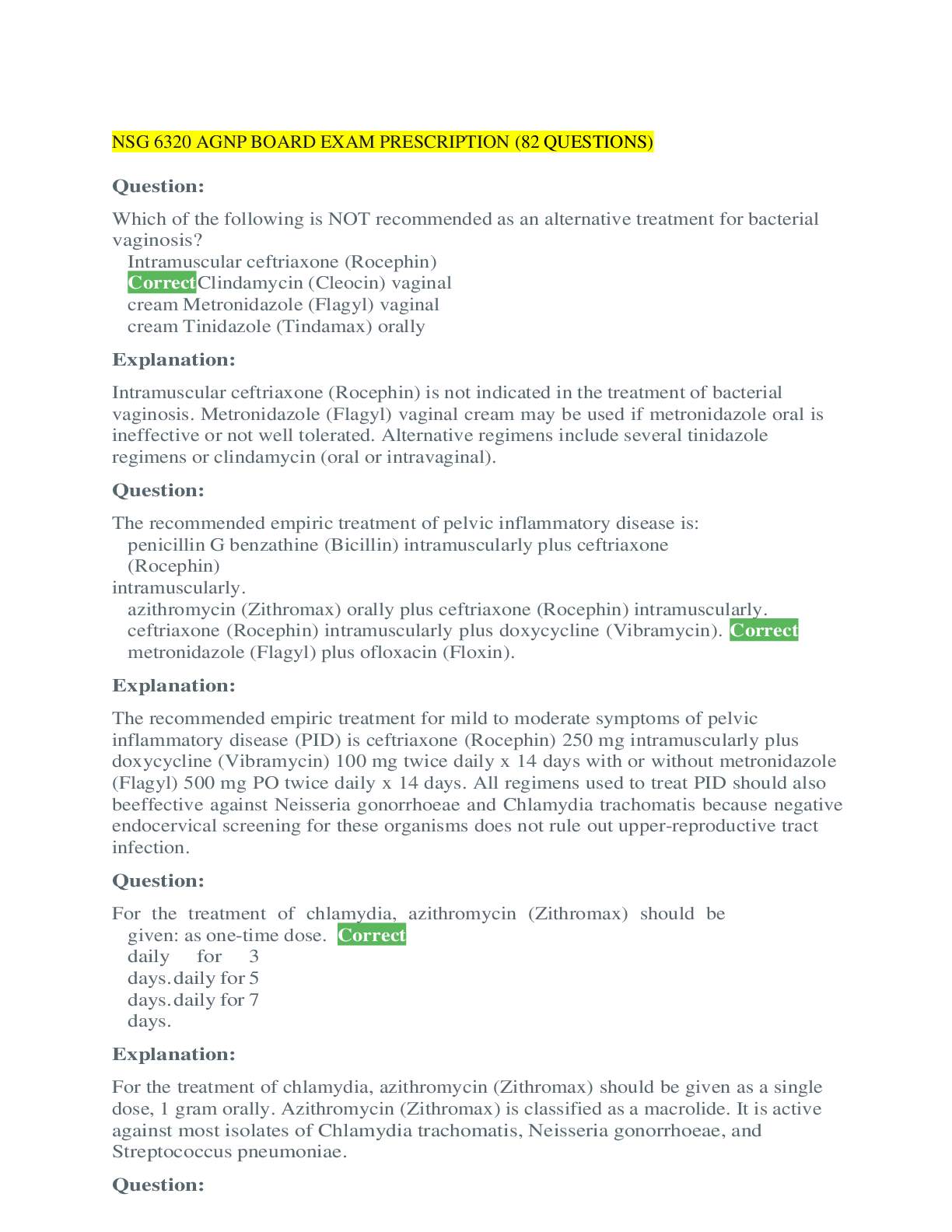




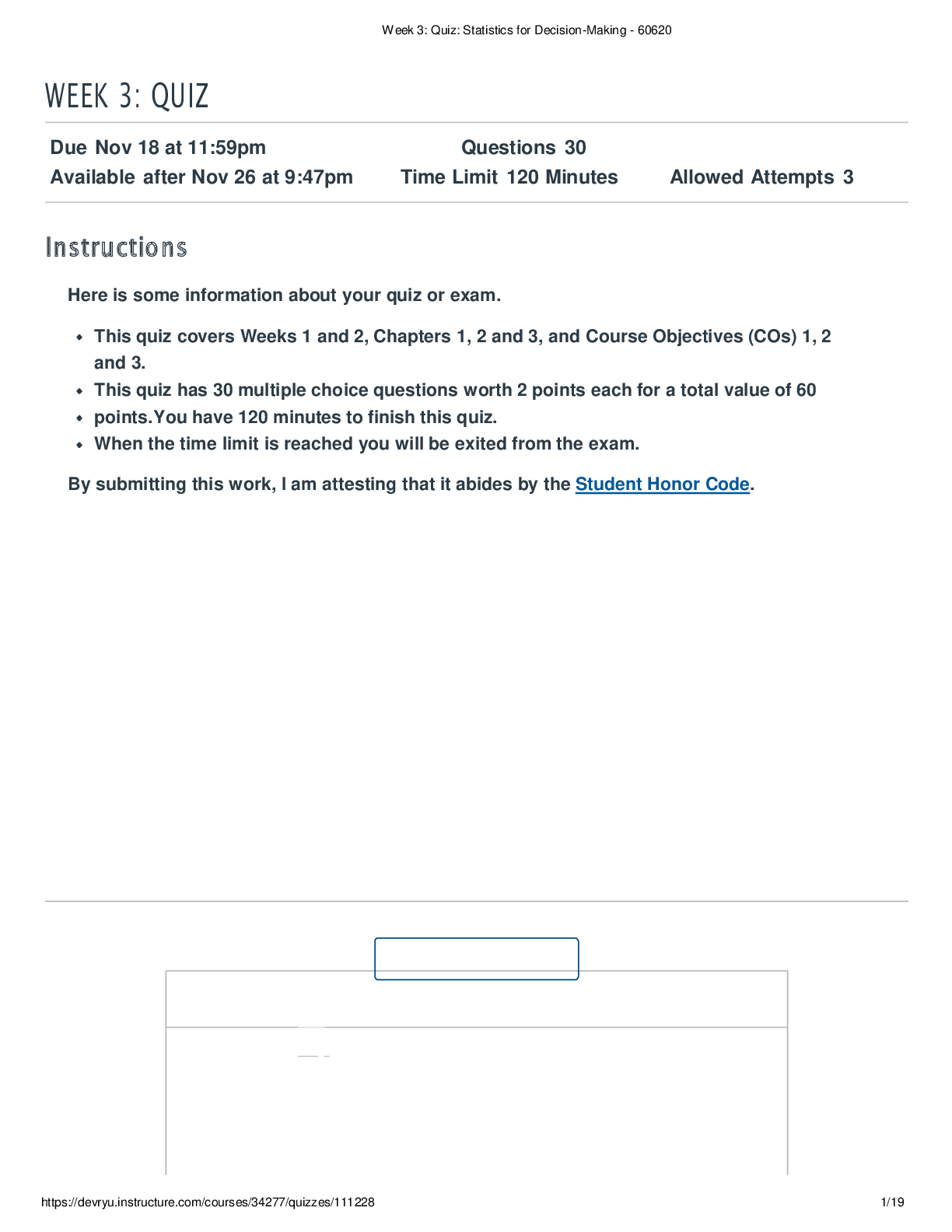

.png)











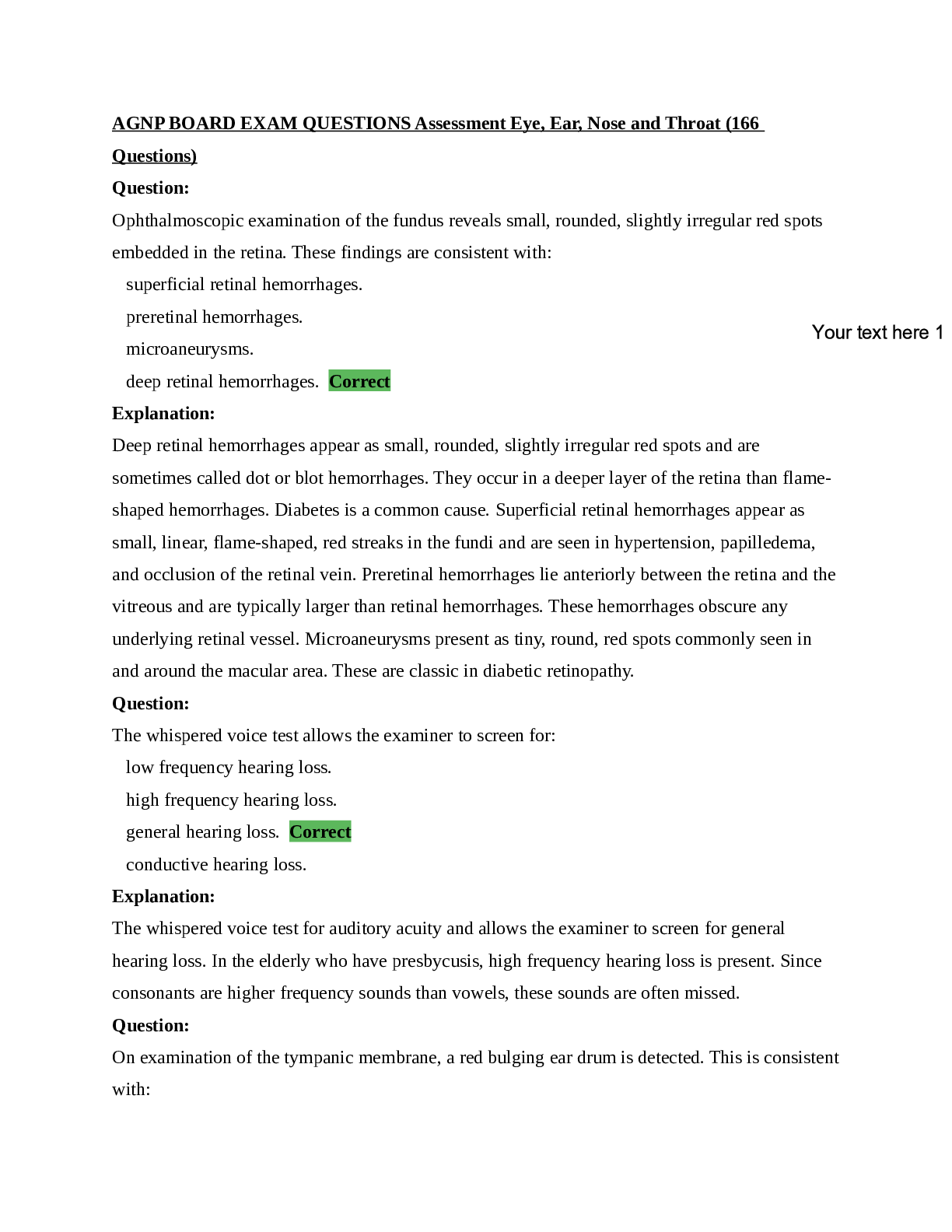
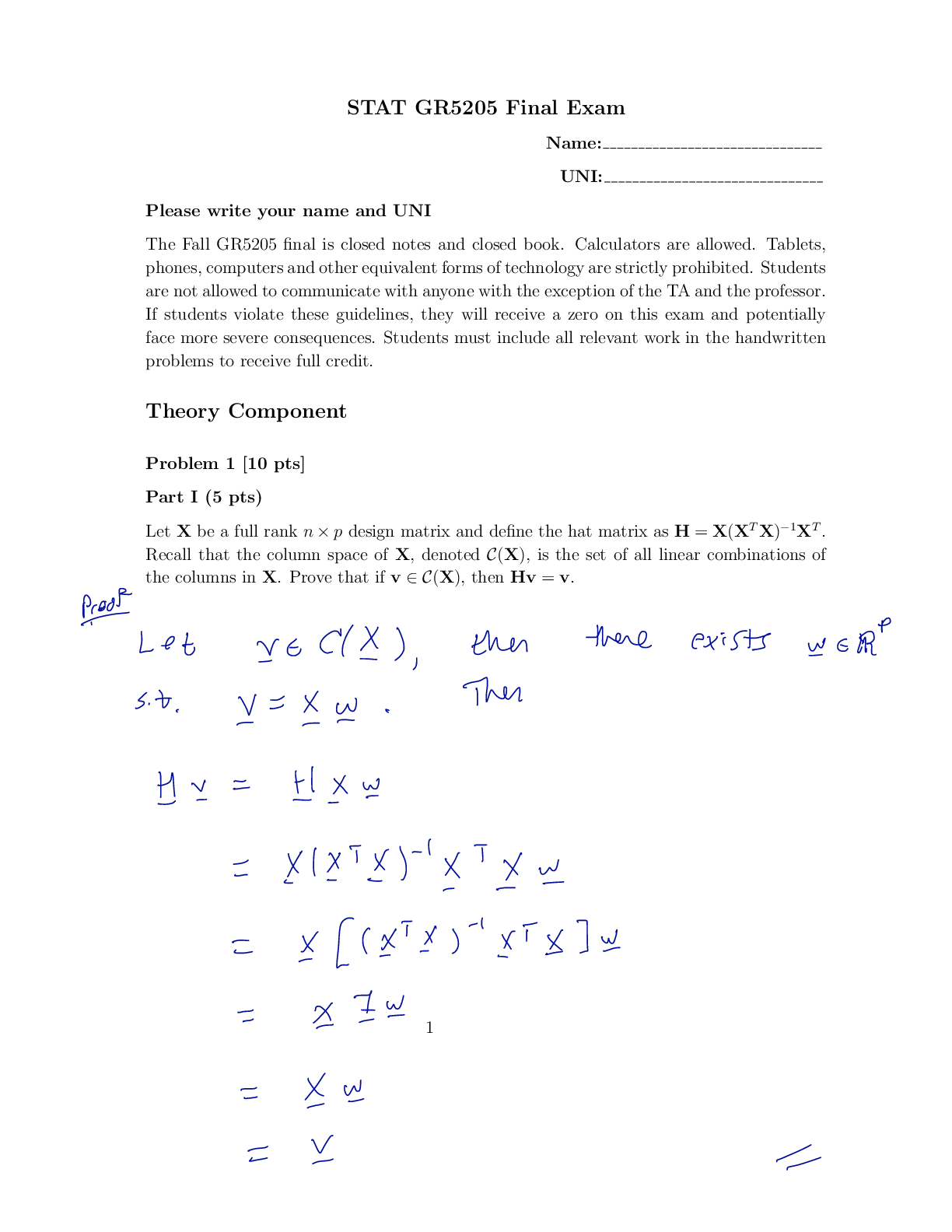
 - South University.png)
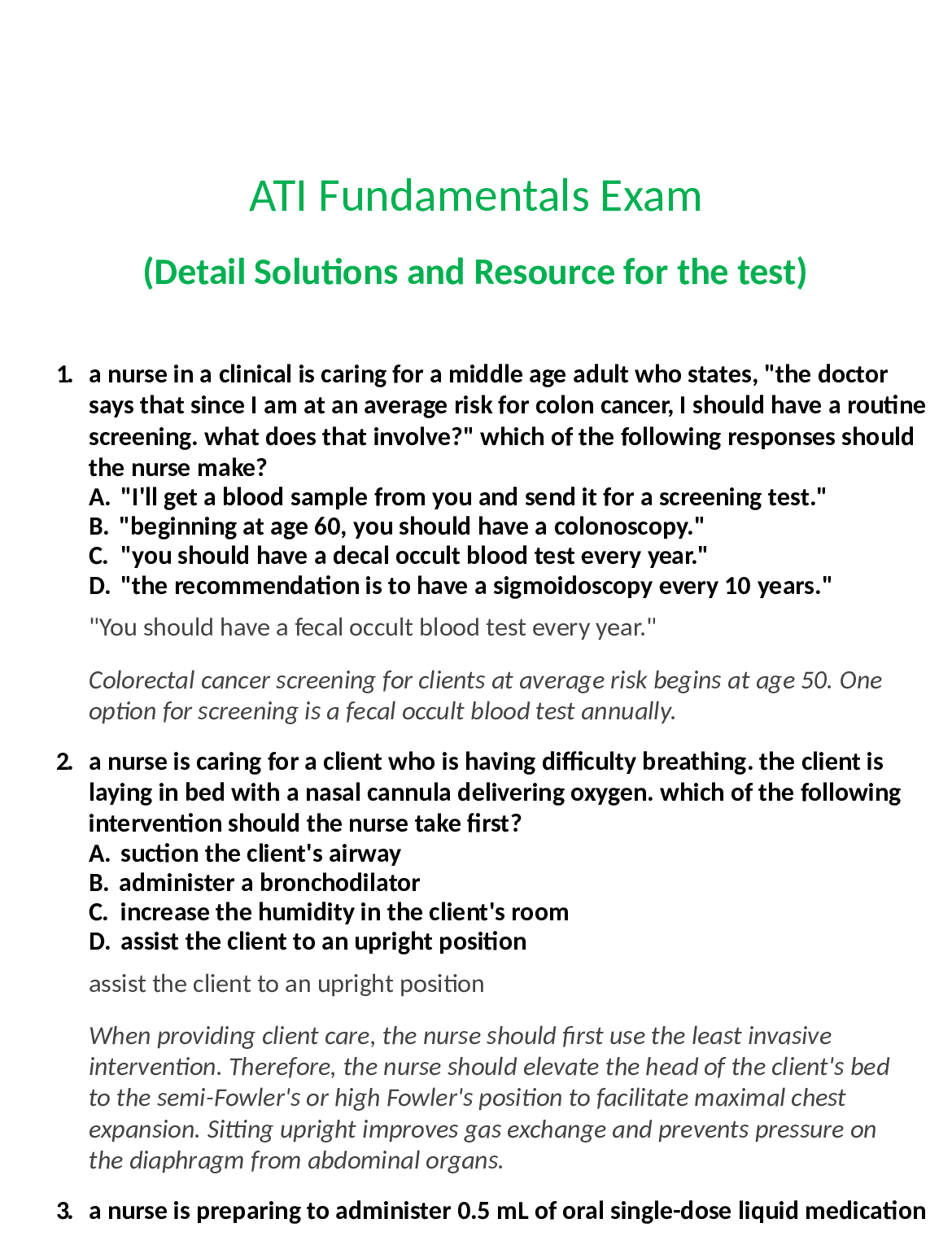
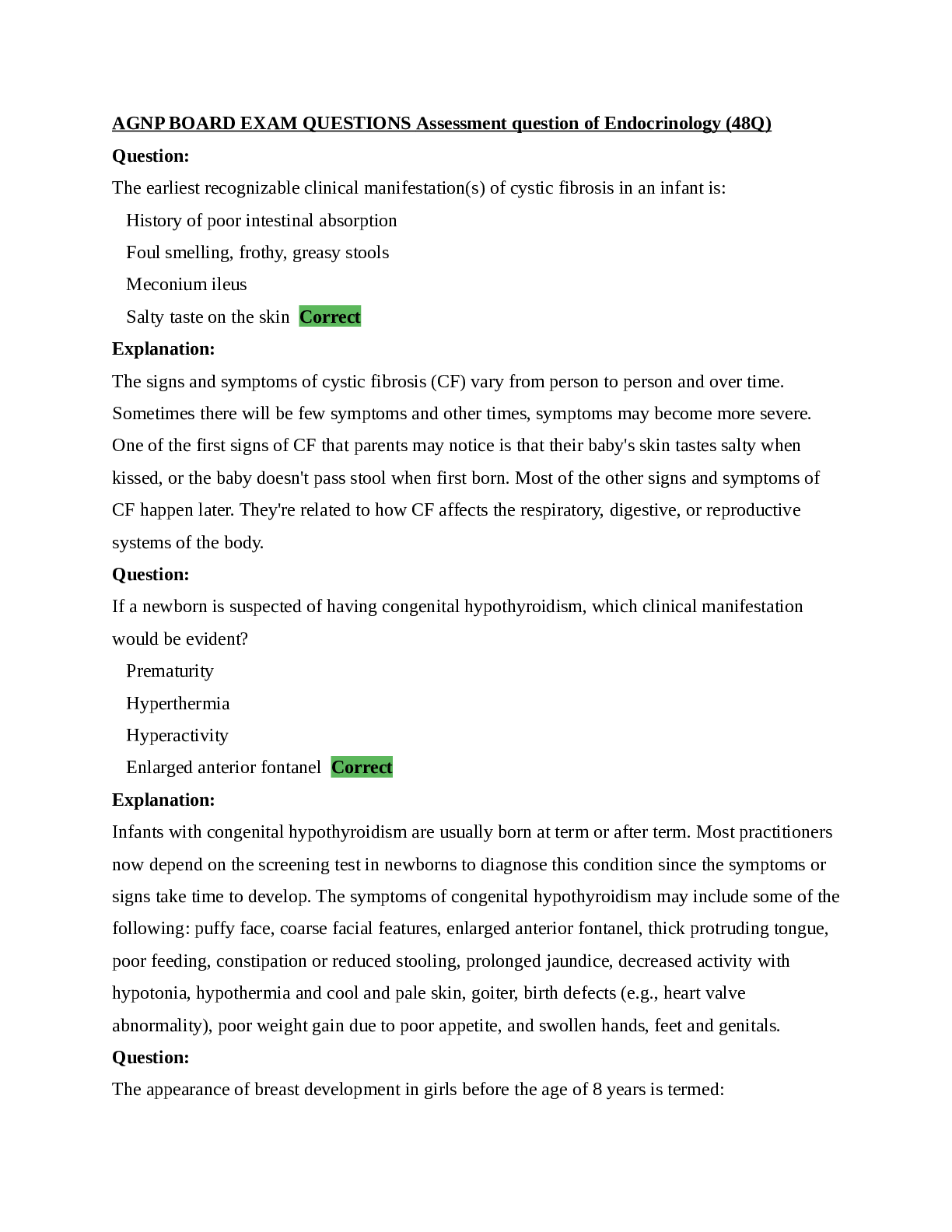
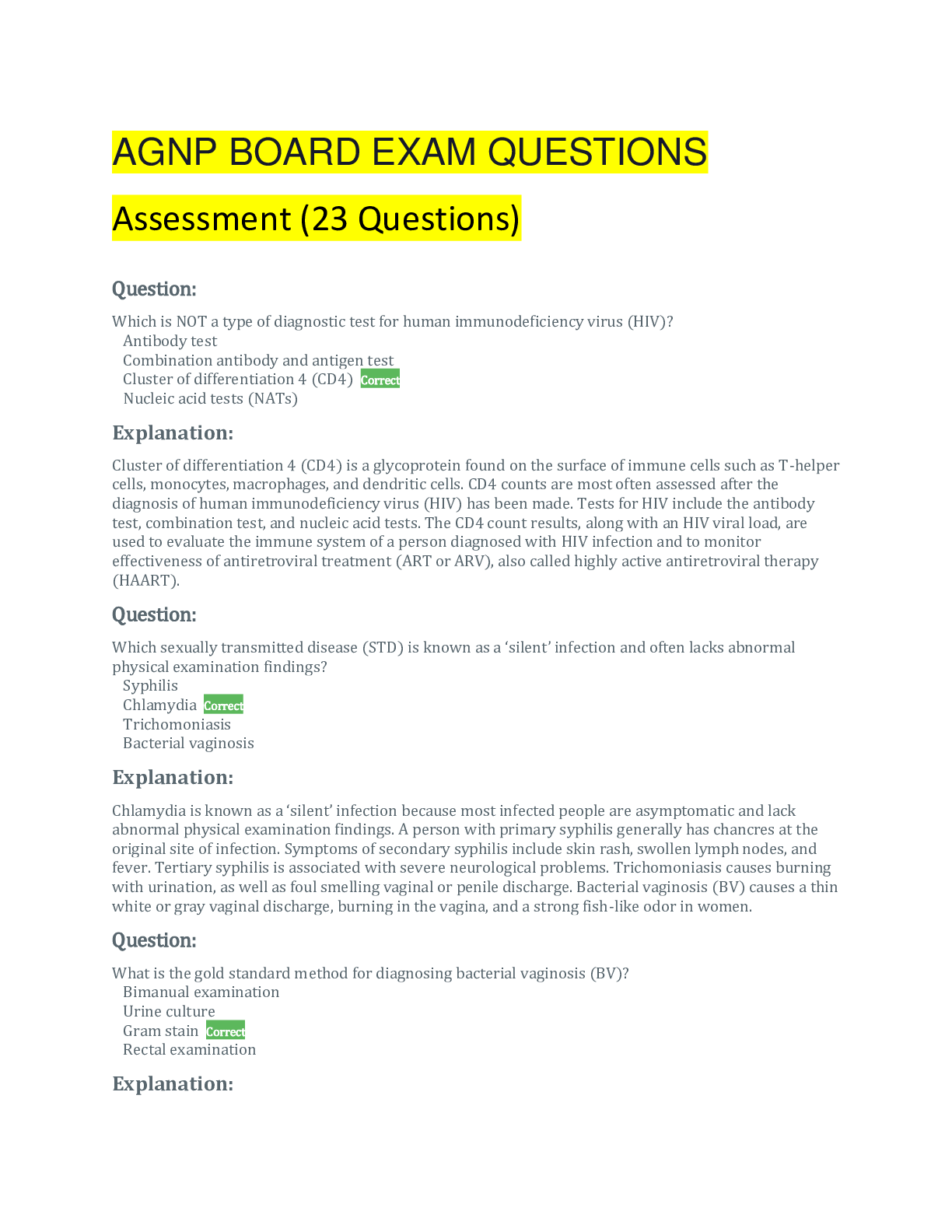
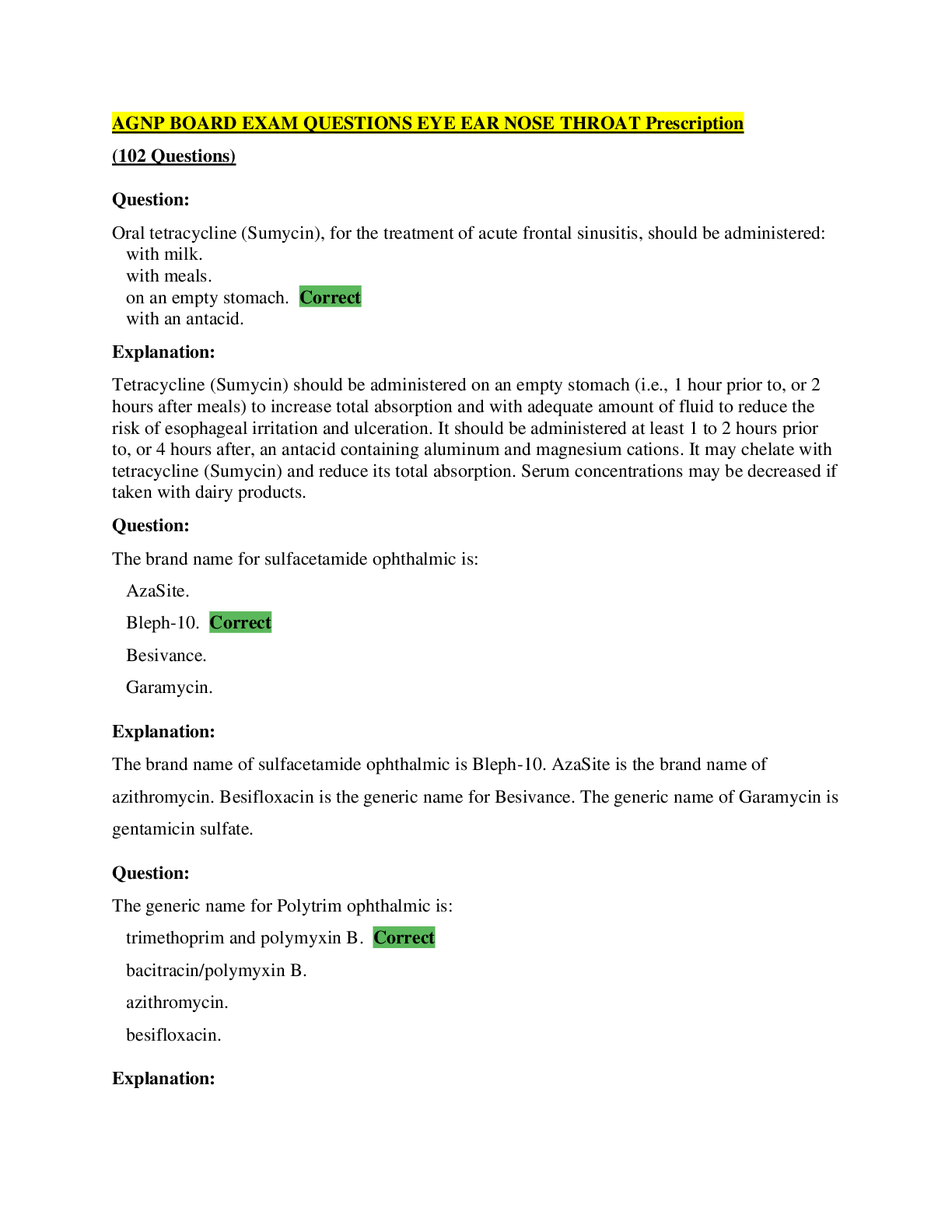
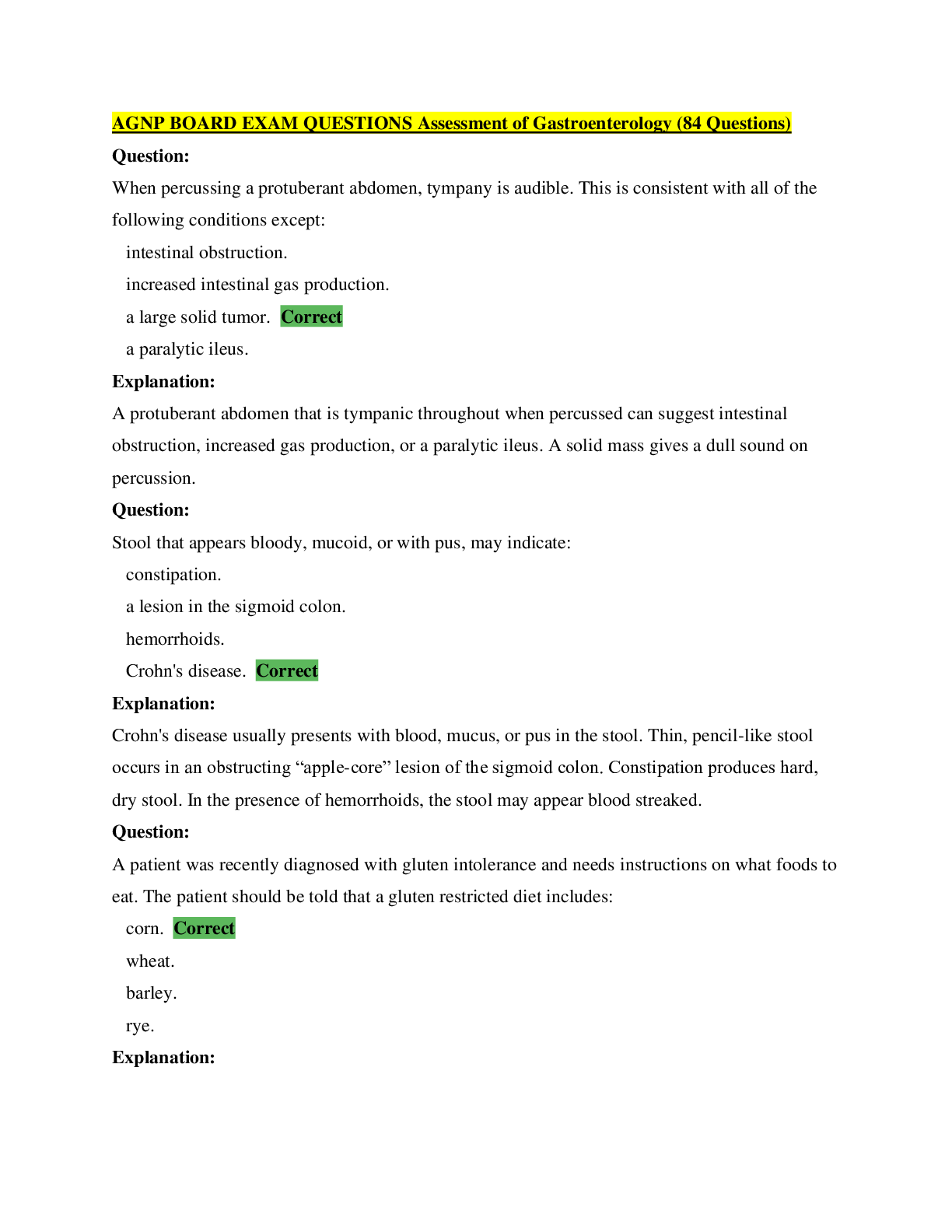
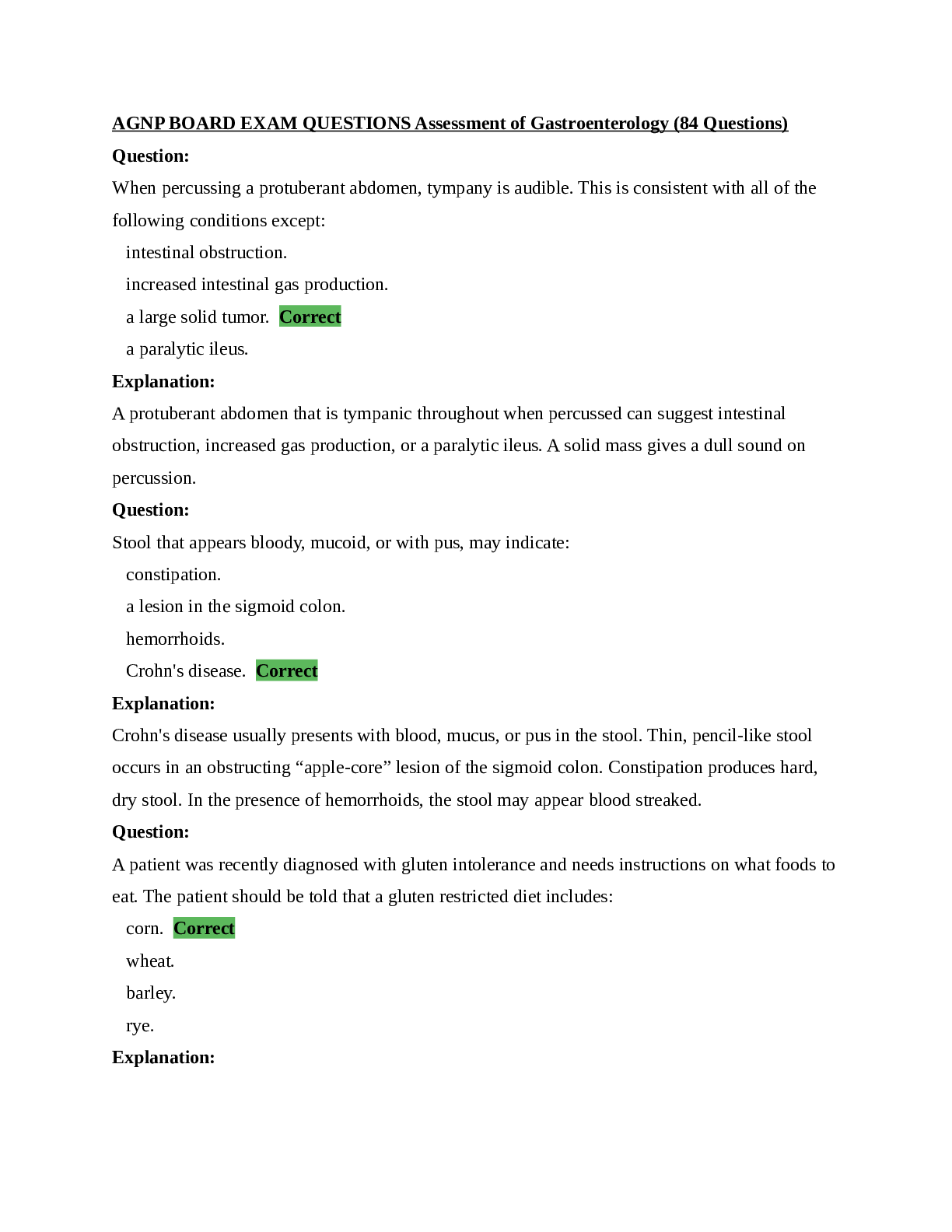
 – South University Savannah.png)

